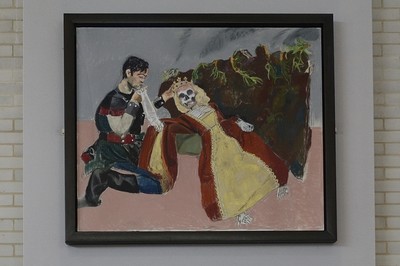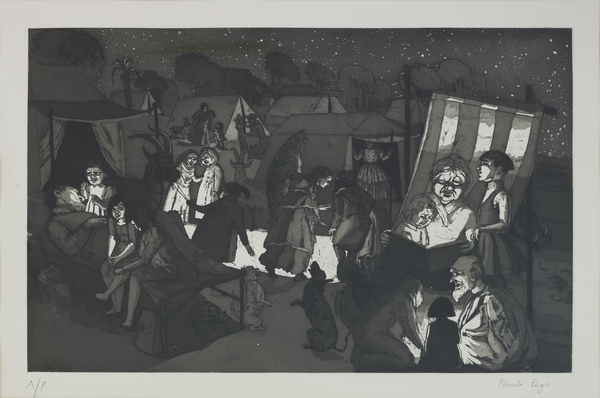Paula Rego
Born 1935 Lisbon, Portugal
Died 2022 London, England
Other name(s) Dame Maria Paula Figueriroa Rego
Biography
Paula Rego was born in Portugal but moved to London at the age of 16. She began at the Slade School of Art (1952-56) in London the year afterwards, where she met fellow artist and husband of 30 years, Victor Willing. She is especially known for her paintings based on folktales and myths, seeing storytelling as ‘a vehicle for exploring the essence of human relationships’. Many of her works draw on childhood memories of living under the dictatorship of Antonio de Oliveira Salazar with his repressive Catholic regime (1932–68) . The oppression of women is clear within some of these artworks; in particular, Rego expressed her frustration at the apathy of the Portuguese public who failed to vote for the legalisation of abortion. The First Associate Artist at the National Gallery (1990) and Dame of the British Empire (2010), she has been the subject of many exhibitions across the world, with a dedicated museum in Cascais, Portugal.
Artwork Information
Ines de Castro (2013)
In 2014 Paula Rego offered to create a work for The Women’s Art Collection to mark the College’s 60th Anniversary. We were asked to choose a subject and, taking inspiration from the history and folktales of Rego’s native Portugal, we chose Inês de Castro. Inês was a 14th-century Galician noblewoman, who had an illegitimate affair with Prince Pedro of Portugal and was brutally murdered by his father, King Alfonso IV. Allegedly, when he ascended to the throne Pedro exhumed Inês’ corpse and gave his dead lover a lavish coronation.
The painting was created as a response to Maggi Hambling’s Gulf Women Prepare for War (1986), which it hangs alongside in the College’s Dome. Aside from their common themes of violence, nationalism and gender, there are echoes between the paintings’ colour schemes and compositions: in both works the pale, dusky pinks are contrasted with dark greens and browns and the female soldier’s gun which cuts diagonally across Hambling’s painting finds a match in Inês’ recumbent pose.
Encampment (1989)
Encampment (1989) is related to a series of hand-coloured black-and-white etchings entitled ‘The Nursery Rhymes’, made in collaboration with printer Professor Paul Coldwell of Culford Press. Along with another etching (Secrets and Stories), Encampment frames the overall theme of the series, and these were exhibited as a whole for a solo exhibition at Marlborough Gallery in 1989. About the series, historian Marina Warner (1989) says of Rego: ‘Her sympathy with naiveté, her love of its double character, its weakness and its force, has led her to Nursery Rhymes as a new source for her imagery.’
Storytelling is an integral theme within Rego’s practice. Often thought to be the domain of women and maintained through intergenerational oral tradition, folktales and nursery rhymes constitute intimate bonding rituals that are inimical to authority. Rego explains, ‘When I was a child in Portugal there was very much an oral tradition of story telling – many of the tales related had never been written down. I cannot separate my own childhood from the imagined terrors and exquisite thrills of their robust imaginings.’ For Rego, the fairy tales give structure to this darkness with its concealed chaos – lurking in this particular etching in the shadows, the ‘imagined terrors’ – and through repetition provide comfort to children.



